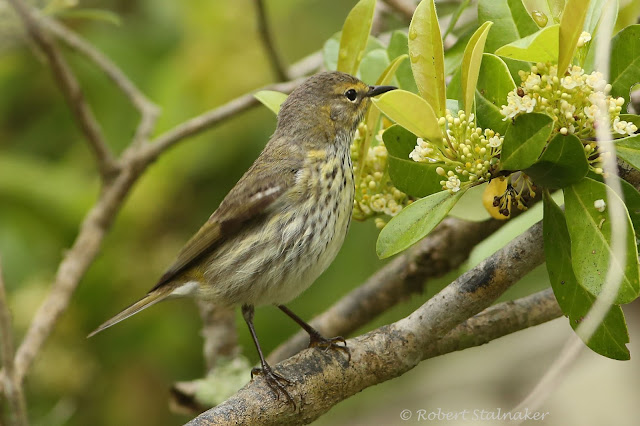Stray, orphan, curious? This cute Bobcat kitten ...
We heard two Yellow-billed Cuckoos for sure and a third one a mile away but we don't know if it could have been one of these two. Twenty Cedar Waxwings and three Northern Bobwhite were some other highlights. White Pelicans are still lingering. Saw five Marsh Rabbits. The best dragonfly spotted today was a Painted Skimmer. Members in party were Karen Hamblett, Pam Meharg and Paulette Fiske.
26 Apr 2013, Lake Apopka Bike Trail
Janet Leavens and I had a good day on the Lake Apopka Bike Trail. Eli Schaperow later joined us. Both male and female Orchard Orioles along with fifteen Bobolink were the highlights. Some late migrants still lingering were the Belted Kingfisher, House Wren and Marsh Wrens. Other nice sightings were two Least Bittern, Black-crowned Night-heron in-flight (2 juv, 3 adult), Blackpoll Warblers and a Northern Waterthrush--61 species over a 3 mile walk.
25 Apr 2013, Lake Apopka Bike Trail
Two male Orchard Orioles as well as ...
24 Apr 2013, Wekiwa Springs State Park, Markham Tract
What is black and white and all over, as in all over one tree?
In close proximity to each other in one tree, there were two Carolina Chickadees (looked like they were copulating at one point), four Blackpoll Warblers and one Black-and-white Warbler. A total of seven Blackpoll Warblers were in this general area, and there were at least four Carolina Chickadees and two Black-and-white Warblers. Later, two Blue-gray Gnatcatchers flew in to break up the black and white show.
It tried to land on a young Longleaf Pine but had trouble getting a footing. It finally figured out how to land but then took off to grab some very small prey on the ground. It proceeded to make three more quick attacks on the ground but grabbing prey that was very small, maybe bugs it gulped them so fast. It looked like it was using up far more energy flying and attacking than what it was getting from its hunting--bigger prey will be on the menu soon if it hopes to survive. The rufous shoulder seems more intense than most young of this species and the white crescent on the wing tips shows well.
23 Apr 2013, Mead Gardens
Re-visited the same location this morning, as did some migrants. Or, was it a new batch of migrants replacing the old?
Like yesterday, both male and female Cape May Warblers were present, as were the ...
Black-and white Warblers. While watching two Black-and-white Warblers, a Blackpoll Warbler landed just above one of them. I saw two brilliant male Indigo Buntings as well as females. After seeing a good number of male Common Yellowthroats, a female finally showed and American Redstarts were plentiful. The female Northern Flicker was hanging around the same territory but there was no sign of a male. A thrush of the genus Catharus was seen but too briefly to make an ID. More Ovenbirds were in the gardens today than yesterday. I saw a female yesterday, and today I saw the male ...
American Goldfinch. They must have had a lover's spat since they were widely separated from each other.
American Redstarts, both male and female, were in the swamp and Boardwalk area. Near this Ovenbird, a Black-and-white Warbler was foraging, and near that warbler was a female Northern Flicker. Ellen and Marcus reported Blackpoll Warblers from the other side of the gardens near the azaleas but I failed to find them.
The migrant of the day ...
... was the Black-throated Blue Warbler with multiple sightings near the boardwalk.
Give a gift of a camera this graduation season. It may start a lifelong passion of nature for a loved one.
































